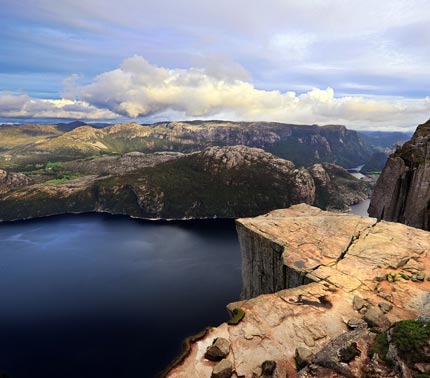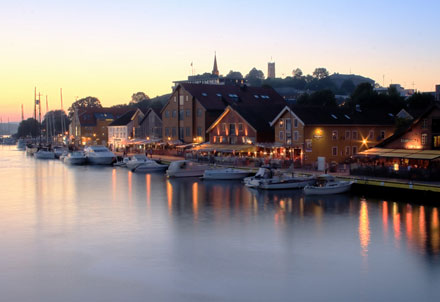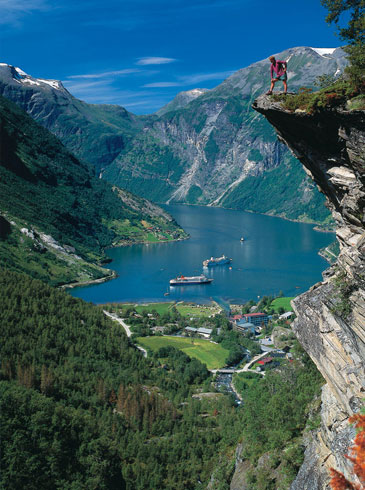Norway
Country statistics

Land area: 118,865 sq miles (307,860 sq km)
Total area: 125,181 sq miles (324,220 sq km)
Population (2010 est.): 4,676,305 (growth rate: 0.3%); birth rate: 10.9/1000; infant mortality rate: 3.5/1000; life expectancy: 80.1; density per sq km: 15
Capital City: Oslo
Monetary unit: Norwegian krone
Languages: Bokmål Norwegian, Nynorsk Norwegian (both official); small Sami- and Finnish-speaking minorities (Sami is official in six municipalities)
Ethnicity/race: Norwegian, Sami 20,000
Religions: Evangelical Lutheran 86% (state church), Pentecostal 1%, Roman Catholic 1%, other Christian 2% (2004)
Country introduction

Norway is on a large peninsula shared with Sweden in the north of Europe. In the north, it also borders Finland and Russia.
Norway is a country of natural beauty characterized by deep fjords with carved valleys, high mountains and a coastline of approximately 3000 km (1,864 miles). The incredible fjords have many scenic and narrow branches and are sprinkled with picturesque villages, waterfalls and imposing glaciers. The vast majority of the land is a rocky wilderness, and thus Norway has large, completely unpopulated areas, many of which have been converted to national parks. Even outside the national parks, much of the land is unspoiled nature.
This coastline is broken by many fjords with steep, high and rocky banks. This coastline stretches from the far south to the Arctic North Cape and in some areas is dotted with houses and farm sites painted in bright colors.
Norway's highest point is Galdhøpiggen, 2,469 m (8,100 ft) in the Jotunheimen region that lies midway between Oslo and Trondheim, but away from the coast. In the far north (Finnmark), flatter open spaces can be found. Several of the worlds greatest waterfalls are in Norway, particularly in the western fjords and the mountain region.
The culture

Norway's culture maintains its roots from the old era, featuring at the same time the characteristics of a modern Western European country. Norwegian society today is based on values such as democracy and freedom of expression and features a strong feeling of fairness, equality and egalitarianism.
People have a close relation with their natural environment that has fostered many outdoor social activities such as hiking, biking or skiing, and it is very common for people to start these activities at a very early age.
Traditions and festivals throughout the year, along with the people's peaceful manner, good mood and humor, are all part of the Norwegian cultural heritage that continues to flourish. Among the traditional celebrations, the most important ones are the Norwegian Constitution Day, the days of Advent and the Christmas season, and the Easter celebration.
Attractions & landmarks

The nature of Norway offers some of the most magnificent landscapes in the world. Especially beautiful are the numerous fjords and other glacier shaped valleys that have formed some of the most impressive waterfalls and extreme cliffs in the world.
The grandest and most spectacular fjords are on the west coast in the southern half of the country. Sognefjord is the world's deepest at 1,308 m (4,291 ft) and longest at 205 km (127 miles) fjord. It can be reached by car or boat, or onboard one of the world's most beautiful train rides. The train trip begins with the scenic Bergen Railroad which connects Oslo and Bergen.
To the south, near the city of Stavanger, Lysefjorden offers an amazing surprise along the steep walls of the fjord. Preikestolen, or "Pulpit Rock", gets its name from its unusual shape and is famous landmark of Norway. The view that's opening from the top of the rock is astounding. Not much people have the courage to come to the cliff's edge and look straight beneath, where two thousand feet down the waves of Lysefjorden fjord are splashing.
Tønsberg is Norway's oldest town situated in the south near the Swedish border. It's mostly known for its Vikings' history since the town was founded in the 9th century and is surrounded by some of the county's major tourist attractions, including old viking graves and museums.
Geirangerfjorden (The Geiranger Fjord) is one of the most beautiful fjords of Norway. In the middle of the Geirangerfjord there are two waterfalls facing each other on the opposite walls of the fjord. The small village of Geiranger is located at the end of the fjord where the Geirangelva river empties into it.